
Israel has carried out repeated attacks in Gaza and killed about 100 Palestinians over the past two weeks since the U.S.-backed ceasefire deal with Hamas came into effect. Jeremy Scahill, co-founder of Drop Site News, is one of the few Western journalists in regular contact with Hamas leaders. “It’s utter malpractice on the part of all of these news organizations that have not regularly been interviewing the leaders, the negotiators of Hamas and Palestinian Islamic Jihad. This is, by default, allowing the dehumanization narrative of Palestinians to just take hold,” he says.
Transcript
AMY GOODMAN: This is Democracy Now!, democracynow.org, The War and Peace Report. I’m Amy Goodman.
We turn now to Gaza, where Israel has carried out repeated attacks, killing about 100 Palestinians over the past two weeks since the U.S.-backed ceasefire deal with Hamas came into effect. Israel has also continued to restrict the entry of humanitarian aid into Gaza in defiance of a ruling last week by the International Court of Justice, as Palestinian families are still in urgent need of food, clean water, fuel and shelter. Instead of the approximately 600 aid trucks per day pledged by Israel, it’s reportedly allowing in only about 80 to 90 trucks a day.
As part of the truce, Hamas released all the Israeli hostages, agreed to release the bodies of deceased hostages. Hamas says it’s working with the Red Cross and others to search for the remaining bodies. The main group representing families of hostages is calling on Israel to refuse to proceed to the next phase of the truce until the final 13 hostages’ bodies are returned. This is Israeli government spokesperson Shosh Bedrosian.
SHOSH BEDROSIAN: What I can share with you is the team is using between two to three excavator machines and two to three trucks to search for our deceased hostages. Now, the Red Cross and the Egyptian team are allowed entry beyond the IDF’s yellow line position into Gaza territory to conduct the search for our hostages.
AMY GOODMAN: Gaza authorities say an estimated 10,000 Palestinians may be trapped under the rubble, and have called for access to the same equipment used to search for the dead Israeli hostages.
Meanwhile, UNRWA, the United Nations Relief and Works Agency for Palestine Refugees, warns people in Gaza are increasingly in need of warmth, as cold weather approaches, writing in a social media post, quote, “Shelter materials and winter supplies for displaced families are sitting in UNRWA warehouses in Jordan and Egypt, blocked from entry.”
For more on the ceasefire, violations of the deal, and if it’ll last, and what the next steps are, we’re joined by Jeremy Scahill, co-founder of Drop Site News, where he’s been closely covering the Gaza ceasefire. He’s the author of Blackwater: The Rise of the World’s Most Powerful Mercenary Army and Dirty Wars: The World Is a Battlefield.
Welcome back to Democracy Now!, Jeremy. If you could start off — I mean, you’re in a really unique position. You’re one of the only Western journalists to regularly interview Hamas and Palestinian Islamic Jihad. You broke the story that they had accepted the ceasefire deal, more than half an hour before President Trump announced it. Talk about where you see it standing today.
JEREMY SCAHILL: I mean, first of all, on the issue of speaking to Hamas or Palestinian Islamic Jihad, this should be basic journalistic practice. In fact, it’s utter malpractice on the part of all of these news organizations that have not regularly been interviewing the leaders, the negotiators of Hamas and Palestinian Islamic Jihad. This is, by default, allowing the dehumanization narrative of Palestinians to just take hold. When the United States and Israel make allegations against Hamas, against Islamic Jihad, against the Palestinian armed resistance, the job of journalists should not be to just say, “Oh, well, they’re verboten. We can’t speak to them.” Our job should be to say, “Let’s fact-check these governments. Let’s talk to these people.”
And when the U.S. started directly speaking to Hamas, in the form of Adam Boehler, who is a college friend of Jared Kushner, his former roommate — he was the special envoy on hostages. He goes and he speaks with Hamas leaders. And I spoke to those very leaders that Adam Boehler spoke to. Boehler comes out and does interviews not just on CNN, but on Israeli television, saying these guys are not what has been presented. This becomes dangerous, because when you humanize people on the other side, you start to fact-check a 77-year narrative of Israel that’s been bolstered by the U.S., that’s how actually you get a human understanding. The Palestinians have a great range of views on Hamas, and that’s for Palestinians to decide. But what has been enabled by large, powerful media corporations is a total silencing of the voices of Palestinians, which is why, then, you end up with this cartoonish portrayal: “Oh, they’re just terrorists.” These guys are doctors. They’re lawyers. They’re veterinarians.
AMY GOODMAN: Well, tell us —
JEREMY SCAHILL: They’re chemists.
AMY GOODMAN: Tell us who they are. Tell us — name them and tell us who they are.
JEREMY SCAHILL: Yeah. Well, first of all, I mean, Khalil al-Hayya, who is the political leader in Gaza of Hamas, was a top aide to Yahya Sinwar, the former leader of Hamas who was assassinated by the Israelis. And Yahya Sinwar himself — all of these guys, their biographies, they grew up in a concentration camp. They grew up in an open-air prison in Gaza. You could tell a biography of every one of the leaders of Hamas, including the guys who Israel says, “Oh, they live in five-star hotels abroad.” All of them have had direct family members killed. Khalil al-Hayya, multiple sons of his were killed, including one of his sons killed in the September 9th attempt to assassinate the negotiators in Qatar. Basem Naim, another one, a doctor educated in Germany, but from Gaza, he has had multiple family members killed, including recently his son. These are all — if you contrast the leadership of Hamas —
AMY GOODMAN: In the bombing, Qatar.
JEREMY SCAHILL: In the bombing of Qatar. You know, they did — they failed to kill any of the senior Hamas officials, but they did kill multiple administrative staff, including Khalil al-Hayya’s secretary. They not only bombed — they hit with 12 missiles. They not only bombed the offices that Hamas had in Qatar, at the request of the United States — Hamas was in Qatar to do these kinds of negotiations — but they hit the residence of Khalil al-Hayya. They wounded his wife, his daughter-in-law. They killed his son. And they wounded multiple grandchildren, some of them very seriously. You contrast that with Netanyahu’s son, who’s running around Miami, living his life like a spoiled frat boy. Khalil al-Hayya has had multiple sons killed.
So, you can have a debate — and Palestinians do — about what Hamas is, but it is total journalistic malpractice that more news organizations are not saying, “We need to aggressively report: What is their perspective? What do they say to these allegations?”
AMY GOODMAN: So, talk about their perspective on the ceasefire, and how you reported the ceasefire deal before Trump announced it, what they agreed to early on and what ended up —
JEREMY SCAHILL: Yeah.
AMY GOODMAN: — being agreed to. And then we’re going to talk about the bodies of hostages —
JEREMY SCAHILL: Yeah.
AMY GOODMAN: — on both sides.
JEREMY SCAHILL: Let’s remember that when Joe Biden and Kamala Harris were in office, they brokered one short truce, a month into the war, in November, where there were — as an exchange of captives. There was an opportunity to end the war right there. And Biden — the main difference between Biden and Trump is Trump is a transactional guy. You should think of him as having these spheres of influence that are constantly circling his face, and whichever one he sort of captures at a moment, he then focuses on it. I don’t think Trump could actually define what Zionism is. You know, he talks about Miriam Adelson: “Oh, she’s got $60 billion in the bank.” He has people that are hardcore Zionists in his administration. But then he also is very close to all of these Arab Gulf monarchies and is — and he’s doing business with them in the private sector and now in the White House, his son-in-law Jared Kushner bankrolled to the tune of billions of dollars from Qatar, Saudi Arabia, the United Arab Emirates. So, he’s a transactional, erratic character that ultimately is looking to make constant real estate deals and cut — you know, cut off the top for profits for himself. Biden, committed Zionist ideologue his entire political career.
So, Matt Miller, the former State Department spokesperson under Joe Biden, admitted recently in an interview with Israeli television that the Biden administration allowed Netanyahu to repeatedly sabotage ceasefires and that they didn’t go after him in a real way, for fear that it would jeopardize a ceasefire. I mean, just think of the logic of it. But this is — this was admitted by the State Department spokesperson that that was the default policy of Biden.
So, when Trump becomes the president-elect, he then says, “I want a ceasefire by the time that I come into office.” And part of this was just his ego. “I’m going to” — he said, “I’m going to end the war in Ukraine, you know, within an hour of taking office, or a day of taking office.” You know, a lot of this was bluster. He would say whatever he needed to say to win. He also was able to exploit the fact that Kamala Harris’s position, when asked about all of this, was “I wouldn’t change a thing.” You know, the position on the Gaza war was a huge factor in why Donald Trump took power. And, you know, Democrats need to face that. And Kamala Harris is on this revisionist book tour right now. She doesn’t like it when people bring this up, but that’s a fact. She had an opportunity to distinguish herself from Biden, and she doubled down on “I wouldn’t change a thing.” So, whatever we think of Donald Trump and his motives, there wouldn’t have been that original January ceasefire deal.
Forty-two days into it, Trump allows the Israelis to blow it up. They immediately, on March 2nd, reimpose a massive, full-spectrum blockade on Gaza. We shouldn’t call it “humanitarian aid.” Israel is an occupying power. These are life essentials. Humanitarian aid makes it sound like we need to just supplement the nutrition. They locked Gaza down completely — no food, no medicine, no life essentials — and starvation starts to take hold. March 18th, Israel resumes scorched-earth terror bombing, with the full, enthusiastic support of the White House. And it goes on like that.
To fast-forward a bit through this, there was — there were rumblings about trying to restart a ceasefire process, the U.S. and Israel demanding that Hamas and Islamic Jihad accept what they called the Witkoff framework, 13-point plan that would have started with an initial 60-day ceasefire in exchange of roughly half the captives, that the Palestinians hoped would lead to a permanent end to the war. But there were not great guarantees in it. By August 18th, Hamas officially accepts what the Qatari mediator said was 98% of the terms that the U.S. and Israel had demanded.
Instead of responding to that, Israel begins to publicly threaten the external political leadership of Hamas, culminating with Trump saying, “If you don’t accept this deal, nasty things are going to happen to you” — not talking about the Palestinians in general, talking about the Hamas leadership. It’s very important. Trump, at a time when Israel starts to say, “We’re going to assassinate the external leadership,” the negotiators of Hamas that are in Qatar because the U.S. asked Qatar to house them, it’s pretty clear that Trump — one of two things — either greenlit an operation to kill those leaders or allowed it to happen. This cover story, “Oh, Steve Witkoff just didn’t make it in time to WhatsApp to tell the emir of Qatar” — that’s the — that was the dominant story — is nonsense. And Witkoff then goes on 60 Minutes and tells a different story, that they didn’t know anything about it. So, already there’s a disconnect in their cover story, which is classic for the Trump administration. So, instead of then saying to the Palestinian side, after they accept this deal, “Let’s talk about some of the technical aspects of this,” Israel then conducts an attempt to assassinate the political leadership of Hamas, the chief negotiators of Hamas.
Remember, the last — under Biden, the last real, serious ceasefire discussion was the summer of 2024. Hamas, on July 2nd, 2024, accepted a deal, that the U.S. said they would get Israel to accept. Israel’s response was to assassinate Ismail Haniyeh, the head of Hamas, in Tehran, Iran, where he was attending the inauguration of the new Iranian president. They bombed Ismail Haniyeh in a guest house owned by the most elite unit of the Iranian military. For 77 years, the Israelis are constantly assassinating any Palestinian that is willing to make a deal. And people around the world should be asking why. So, then nothing happens. And they were sitting in Qatar looking at a 100-word ceasefire proposal that they were told came from Donald Trump. They gathered to do this, and that’s when the assassination strike took place.
AMY GOODMAN: The latest assassination strike.
JEREMY SCAHILL: And they failed to kill any of the political leaders. And I knew — personally, I knew two of the senior Hamas leaders that were targets in this, and have interviewed them numerous times: Basem Naim and Ghazi Hamad. I also knew two of the young people that were killed in this strike. They were office assistants. These were guys that, when you meet with Hamas in their offices, are bringing in coffee, or they’re carrying bags. These are the logistical people. They’re young people. That’s who they killed. They didn’t kill any of the senior leaders.
AMY GOODMAN: And how did they kill them? What was the intelligence?
JEREMY SCAHILL: I mean, there’s a lot of stories about this right now. And, you know, the Palestinian story on this is that they were aware that they were targets. You know, the Israeli chief of staff had said, days before this, that “Our arm can outstretch even to the external leadership.” You know, many Palestinian resistance figures don’t go anywhere near a telephone. Those that do carry them, when they go into a meeting — and this is just common sense — obviously aren’t bringing the phone into the meeting. Now, 10 years ago, we would have said that the Israelis were using geolocation data from the phones. We saw this under Obama’s, you know, drone strike program. I think now the Israelis have far more sophisticated technology than we understand. So, people tend to think, “Oh, it was that — you know, it has to do with the phones.”
AMY GOODMAN: Being in another room —
JEREMY SCAHILL: Yeah.
AMY GOODMAN: — where the assistants were.
JEREMY SCAHILL: You know, obviously, the Mossad has extensive intelligence operations all around the world. I think there’s some question of whether the intent was to actually kill Khalil al-Hayya and the negotiators, or the intent was to do exactly what they did, try to kill family members and others as a warning shot. I don’t have any information about it. I just — I think Israel doesn’t often miss its target in this capacity.
AMY GOODMAN: Jeremy, talk about what’s happening now. As the second phase is being discussed, how is the Palestinian leadership, and who is the Palestinian leadership, that is organizing right now, both in Gaza and the West Bank?
JEREMY SCAHILL: This is another great example of media malpractice. We use the word “Hamas” because Hamas is leading the negotiations. They are the combatants in this war in a military sense, because they’re holding the Israeli captives. They’re the fighting force, Hamas and Islamic Jihad. And they have a mandate, they say, from the Palestinian factions to negotiate an end to this acute part of the war — withdrawal, ceasefire, exchange of captives. But what they’ve said consistently is, any issues about disarmament of the Palestinian people, governance of Gaza, the future attempts to, in a robust way, unify the occupied West Bank, occupied Jerusalem and Gaza under the banner of an independent Palestinian state, those are not the mandate of Hamas.
And so, if news organizations were doing real reporting on this, what they would know is that for much of the genocide, Hamas has consulted with a wide range of political factions, including its political opponents, including people like Dr. Mustafa Barghouti, who doesn’t control an armed force, is a physician that has run for president of Palestine. He has emerged as an incredibly important figure in this, because he has systematically refused to kick armed resistance under the bus, has robustly defended the Palestinian cause, but remains engaged in the world. So, right now what you’re seeing is that Hamas and Islamic Jihad made a limited deal that has to do with this genocide and ending the occupation of Gaza, while understanding that the very future of the Palestinian cause is up for grabs.
And so, in the past several days, there have been a flurry of meetings with a range of political factions. An extraordinary meeting took place between Khalil al-Hayya, the leader of Hamas, and Hussein Sheikh, the designated successor of Mahmoud Abbas, the decrepit, corrupt leader of the Palestinian Authority. Hussein Sheikh is very close to the United States, is very close to Israel. There’s great suspicion about his role in Palestine. But Hamas is in an open, engaged conversation with Fatah. And what the Palestinians are saying, from across the spectrum — and Fatah is also saying this — “We need to have a unified front, because this is a neocolonial agenda.” This is talking about a privatization of Gaza. This is talking about huge investments coming in. This is talking about foreign troops coming in. This will cut to the heart of the very cause for liberation. So, I think all Palestinian factions, regardless of what they think about Hamas or Islamic Jihad, are on — are loosely speaking the same page. They understand the very future is up for grabs.
AMY GOODMAN: Jeremy, before you go, I want to ask you about the dead hostages, the bodies of the dead hostages. The Palestinians are saying they need heavy equipment.
JEREMY SCAHILL: Yeah.
AMY GOODMAN: Red Cross and Egypt, I think, is bringing in the heavy equipment to find these bodies. The question is: Will that equipment be able to stay as people claw their way through the rubble to find their loved ones, as they return to their rubble homes, their demolished homes?
JEREMY SCAHILL: You know, there are believed to be roughly 13 or so bodies of Israeli captives left. The great Yemeni cartoonist Kamal Sharaf had a piece of art the other day that showed a camera snaked to a piece of construction equipment pummeling through the ground past dead Palestinian bodies to try to find one Israeli body.
And, you know, everything that Israel has accused the Palestinians of, Israel does as a matter of doctrine. You know, the confession — the accusation is the confession. And we’ve seen that for two years. Donald Trump said, “What kind of sick people hold dead bodies?” Israel, since 1967, has had a policy of holding the bodies of Palestinians. As of before the genocide, there were believed to be more than 720 Palestinian bodies being held in coolers and numbered graves by Israel. There may be as many as 1,500 Palestinian bodies held by Israel since October 7th. So, estimates are more than 2,000 dead Palestinian bodies are being held by Israel right now. One Palestinian political prisoner, his body has been held since 1980, 45 years. So, when Trump says, “What kind of sick and twisted people hold dead bodies?” Israel does it, since 1967. Estimates of more than 2,000 Palestinian bodies right now. And those bodies that have come back, some of them bound, gagged, ropes around the neck.
While we’re sitting here, Amy, Palestinians are sitting in tents watching screens of this is the tooth of one of the bodies, this is the hand, this is the piece of clothing, because there’s no identification on them. Not to mention the stories of the living hostages freed from Israeli captivity, telling horrifying stories of being tortured, telling the stories of what’s happening to the political leaders that are behind bars in Israeli captivity right now. Let’s talk about hostages. Let’s talk about dead bodies. It’s state doctrine in Israel to do the things that Donald Trump and the world says are sick or sadistic or torture. Look at the Israeli captives and the condition they were in, held for two years under starvation and mass bombing, versus the Palestinians coming with their blinded eyes, limbs removed, in wheelchairs, telling stories of sadistic torture, with dogs urinating on them, with being beaten repeatedly, intentionally infected with scabies and other diseases, looking like they just survived concentration camps.
AMY GOODMAN: Last question, we only have 30 seconds: What about the news of Israel involvement with certain Palestinian clans or families in Gaza?
JEREMY SCAHILL: Yeah, I mean, I would encourage people also to look at Drop Site. We’ve done extensive reporting about this. But throughout history, you always try to find collaborators and bootlickers that you can empower to try to do your dirty work for you. And throughout the genocide, Israeli-backed gangs have been the primary looters. Israeli-backed gangs have been terrorizing the Palestinian population. And right now you have three to five gangs in different parts of Gaza that are operating from the areas that the Israeli military is occupying. You know, roughly 50% of Gaza is under full-blown occupation right now.
And I think you’re going to see an attempt to foment something resembling a civil war. That has failed repeatedly, though. When Hamas did these and the security forces in Gaza did these public executions, there was a lot of focus on this, disproportionate to all the other issues. But law and order, Trump said, needs to be imposed. And I think Trump’s people realize that they’re going to have a tough time doing anything in Gaza without Hamas. It’s been the governing authority for so long. Israel absolutely wants Palestinians to be killing each other, and that’s been the point of this from the beginning of backing these gangs.
AMY GOODMAN: Jeremy Scahill, co-founder of Drop Site News, closely covering the Gaza ceasefire, we thank you very much for being with us.
Coming up, early voting has begun in New York’s mayoral race. A massive rally took place last night, 13,000 people in the Forest Hill Stadium. We will look at the front-runner, Zohran Mamdani. If he wins — he’s got a double-digit lead right now in the polls — he would be the first Muslim mayor. Stay with us.
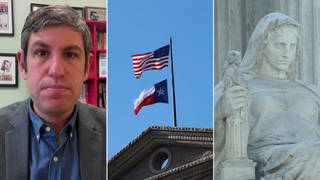
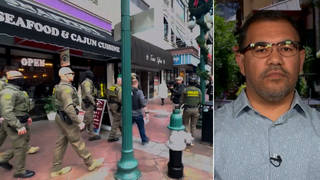
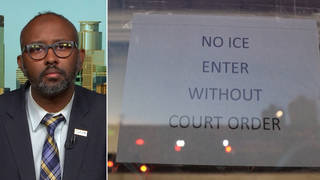
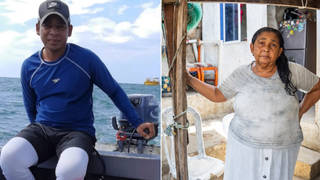

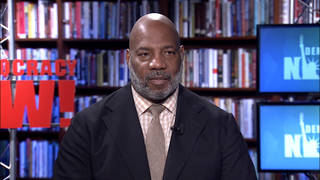
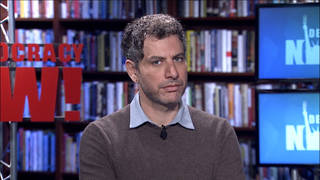
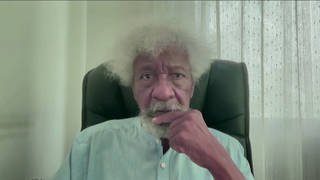
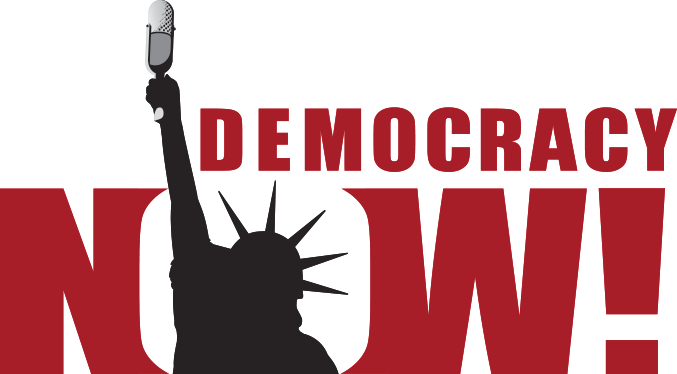
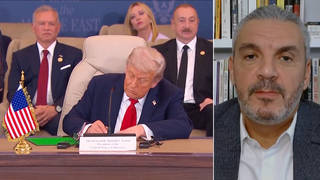

Media Options